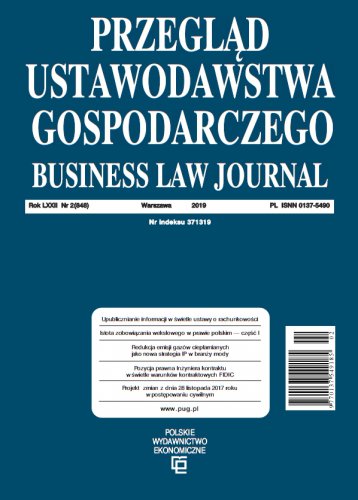The concept of a video sharing platform service in Polish and European Union law
The aim of the article is to analyse the concept of a video sharing platform service in Polish and EU law. This concept was first defined in the provisions of Directive 2018/1808, which is an amendment to Directive 2010/13/EU on audiovisual media services of 10 March 2010, and then implemented in the Polish legal system under the name of video sharing platform by virtue of the Act of 11 August 2021 amending the Broadcasting Act and the Cinematography Act. Determining the meaning of the term of a video sharing platform service is crucial to determining the objective scope of the Broadcasting Act and the application of the obligations it provides for the organisation of content on video sharing platforms, which were first formulated for providers of such services. Despite the adoption of a legal definition of the concept of a video sharing platform service in EU and national law, the determination of the scope of this concept raises numerous interpretation problems that result from the complexity of the definition itself and the vagueness of the wording used. These difficulties are also compounded by the incorrect implementation of Directive 2018/1808 into national law in this respect.
References
Bibliografia/References
Bar, G., & Skibicki, R. (2021). Wyzwania prawne związane z wykorzystaniem sztucznej inteligencji w usługach cyfrowych. Prawo nowych technologii, (1), 40–45.
van Drunen, M. Z. (2020). The post editorial control era: How EU media law matches platforms' organisational control with cooperative responsibility. The Journal of Media Law, 12(2), 166–190. https://doi.org/10.1080/17577632.2020.1796067
Etel, M. (2020). Normatywna koncepcja usług ukształtowana w dorobku Unii Europejskiej. Forum Prawnicze, 1(57), 22–35. https://doi.org/10.32082/fp.v1i1(57).275
Gęsicka, D. K. (2014). Wyłączenie odpowiedzialności cywilnoprawnej dostawców usług sieciowych za treści użytkowników. Wolters Kluwer.
Głowacka, D. (2016). Odpowiedzialność administratorów stron internetowych za treści publikowane przez użytkowników użytkowników w świetle sprawy Delfi AS v. Estonia. W: A. Bodnar, & A. Ploszka (Red.), Wpływ Europejskiej Konwencji Praw Człowieka na funkcjonowanie biznesu (185–207). Wolters Kluwer.
Klafkowska-Waśniowska, K. (2014). Nowe formy usług medialnych a przesłanka odpowiedzialności redakcyjnej w dyrektywie o audiowizualnych usługach medialnych. Zeszyty Naukowe Uniwersytetu Jagiellońskiego. Prace z Prawa Własności Intelektualnej, (2), 112–133.
Klafkowska-Waśniowska, K. (2016). Elektroniczne wersje gazet i czasopism a audiowizualne usługi medialne w prawie Unii Europejskiej i w prawie polskie — glosa dla wyroku Trybunału Sprawiedliwości z dnia 21.10.2015 r. w sprawie sprawie C-374/14 New Media OnLine przeciwko Bundeskommunikationssenat, Europejski Przegląd Sądowy, (8), 45–50.
Kocowski, T. (2018). Podstawowe pojęcia publicznego prawa gospodarczego, W: R. Hauser, Z. Niewiadomski, & A. Wróbel (Red.), System Prawa Administracyjnego. Tom 8a. Publiczne prawo gospodarcze. C.H.Beck.
Koronkiewicz, J. (2015). Terminologia podatkowa a prawidłowość implementacji dyrektyw unijnych w Polsce. Wolters Kluwer.
Kruszewski, A. K. (2019). Komentarz do artykułu 3 Prawa przedsiębiorców. W: A. K. Pietrzak (Red.), Prawo przedsiębiorców. Komentarz.Lex/el.
Kuklis, L. (2020). Media regulation at a distance: video-sharing platforms in AVMS Directive and the future of content regulation. Media Law, (2), 95–110. https://www.medialaws.eu/wp-content/uploads/2020/07/RDM_2_2020-Kuklis.pdf
Kurcz, B. (2004). Dyrektywy Wspólnoty Europejskiej i ich implementacja do prawa krajowego. Zakamycze.
Nałęcz, A. (2015). Materiały wideo na stronie internetowej gazety a stosowanie dyrektywy o audiowizualnych usługach medialnych. Glosa do wyroku Trybunału Sprawiedliwości Unii Europejskiej (druga izba) z dnia 21 października 2015 r. w sprawie C347/14 — New Media Online GmbH. Internetowy Kwartalnik Antymonopolowy i Regulacyjny, 7(4), 136–138.
Piątek, S. (2014). Komentarz do art. 4 ustawy o radiofonii i telewizji. W: S. Piątek (Red.), Ustawa o radiofonii i telewizji. Komentarz. Legalis/el.
Skrzydło-Tefelska, E. (2012). Komentarz do art. 57 Traktatu o Funkcjonowaniu UE. W: D. Miąsik, N. Półtorak, A. Wróbel (Red.), Traktat o funkcjonowaniu Unii Europejskiej. Komentarz. Tom I (art. 1–89). Lex/el.
Śledzieniewska, K., & Włoch, R. (2020). Gospodarka cyfrowa. Jak nowe technologie zmieniają świat. Wydawnictwo Uniwersytetu Warszawskiego.
Staszczyk, P. (2020). Zalecenia, opinie, akty nienazwane, soft low. W: S. Biernat (Red.), Podstawy i źródła prawa Unii Europejskiej. System Prawa Unii Europejskiej. Tom 1 (1092–1125). C.H.Beck.
Woods, L. (2018). Video-sharing platforms in the revised Audiovisual Media Services Directive. Communications Law, 23(3), 127–140. http://repository.essex.ac.uk/id/eprint/23300

